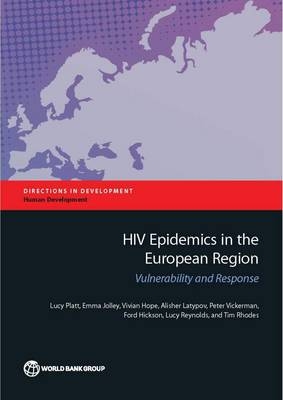
HIV epidemics in the European region
vulnerability and response
Seiten
2015
World Bank Publications (Verlag)
978-1-4648-0388-8 (ISBN)
World Bank Publications (Verlag)
978-1-4648-0388-8 (ISBN)
Provides a systematic review of the evidence on HIV vulnerability and response in all 53 countries of the WHO European Region. It focuses on key populations most at risk of HIV infection: people who inject drugs, sex workers and men who have sex with men. It confirms that these populations are disproportionately affected by the growing HIV epidemic in Europe.
This report provides a systematic review of the evidence on HIV vulnerability and response in all 53 countries of the WHO European Region, stretching from Iceland to the borders of China. It focuses on key populations most at risk of HIV infection: people who inject drugs, sex workers and men who have sex with men. It confirms that these populations are disproportionately affected by the growing HIV epidemic in Europe. Twenty-five percent of HIV diagnoses in Europe are associated with injecting drug use, with much higher proportions in Eastern Europe (33%) than in Western Europe (5%) and Central Europe (7%). Sex between men accounted for 10% of all HIV diagnoses, with higher rates reported in Western Europe (36%), followed by Central Europe (22%) and Eastern Europe (0.5%). HIV remains relatively low among female sex workers who do not inject drugs, (less than 1%), but higher among those who inject drugs (over 10%) as well as among male and transgender sex workers. The analysis highlights the pivotal role of social and structural factors in shaping HIV epidemics and HIV prevention responses. Poverty, marginalization and stigma contribute to the HIV epidemic in Europe and Central Asia. Economic volatility and recession risks are increasing vulnerability to HIV and infections. Barriers to successful HIV responses include the criminalization of sex work, of sex between men, and of drug use combined with social stigmatization, violence and rights violations. HIV prevention requires social and environmental change. The report calls for policymakers and HIV program implementers to target the right policies and programs to maximize the health and social impacts of Europe's HIV responses and get higher returns on HIV-related investments. The report is a product of a collaboration between the World Bank, the London School of Hygiene & Tropical Medicine, the WHO Regional Office for Europe and UNAIDS.
This report provides a systematic review of the evidence on HIV vulnerability and response in all 53 countries of the WHO European Region, stretching from Iceland to the borders of China. It focuses on key populations most at risk of HIV infection: people who inject drugs, sex workers and men who have sex with men. It confirms that these populations are disproportionately affected by the growing HIV epidemic in Europe. Twenty-five percent of HIV diagnoses in Europe are associated with injecting drug use, with much higher proportions in Eastern Europe (33%) than in Western Europe (5%) and Central Europe (7%). Sex between men accounted for 10% of all HIV diagnoses, with higher rates reported in Western Europe (36%), followed by Central Europe (22%) and Eastern Europe (0.5%). HIV remains relatively low among female sex workers who do not inject drugs, (less than 1%), but higher among those who inject drugs (over 10%) as well as among male and transgender sex workers. The analysis highlights the pivotal role of social and structural factors in shaping HIV epidemics and HIV prevention responses. Poverty, marginalization and stigma contribute to the HIV epidemic in Europe and Central Asia. Economic volatility and recession risks are increasing vulnerability to HIV and infections. Barriers to successful HIV responses include the criminalization of sex work, of sex between men, and of drug use combined with social stigmatization, violence and rights violations. HIV prevention requires social and environmental change. The report calls for policymakers and HIV program implementers to target the right policies and programs to maximize the health and social impacts of Europe's HIV responses and get higher returns on HIV-related investments. The report is a product of a collaboration between the World Bank, the London School of Hygiene & Tropical Medicine, the WHO Regional Office for Europe and UNAIDS.
| Erscheint lt. Verlag | 12.2.2015 |
|---|---|
| Reihe/Serie | Directions in development |
| Zusatzinfo | col figs, col. maps, tables |
| Verlagsort | Washington |
| Sprache | englisch |
| Themenwelt | Medizin / Pharmazie ► Gesundheitswesen |
| Medizin / Pharmazie ► Medizinische Fachgebiete | |
| Studium ► Querschnittsbereiche ► Epidemiologie / Med. Biometrie | |
| Studium ► Querschnittsbereiche ► Infektiologie / Immunologie | |
| Studium ► Querschnittsbereiche ► Prävention / Gesundheitsförderung | |
| ISBN-10 | 1-4648-0388-9 / 1464803889 |
| ISBN-13 | 978-1-4648-0388-8 / 9781464803888 |
| Zustand | Neuware |
| Haben Sie eine Frage zum Produkt? |
Mehr entdecken
aus dem Bereich
aus dem Bereich
ein überfälliges Gespräch zu einer Pandemie, die nicht die letzte …
Buch | Hardcover (2024)
Ullstein Buchverlage
CHF 34,95


